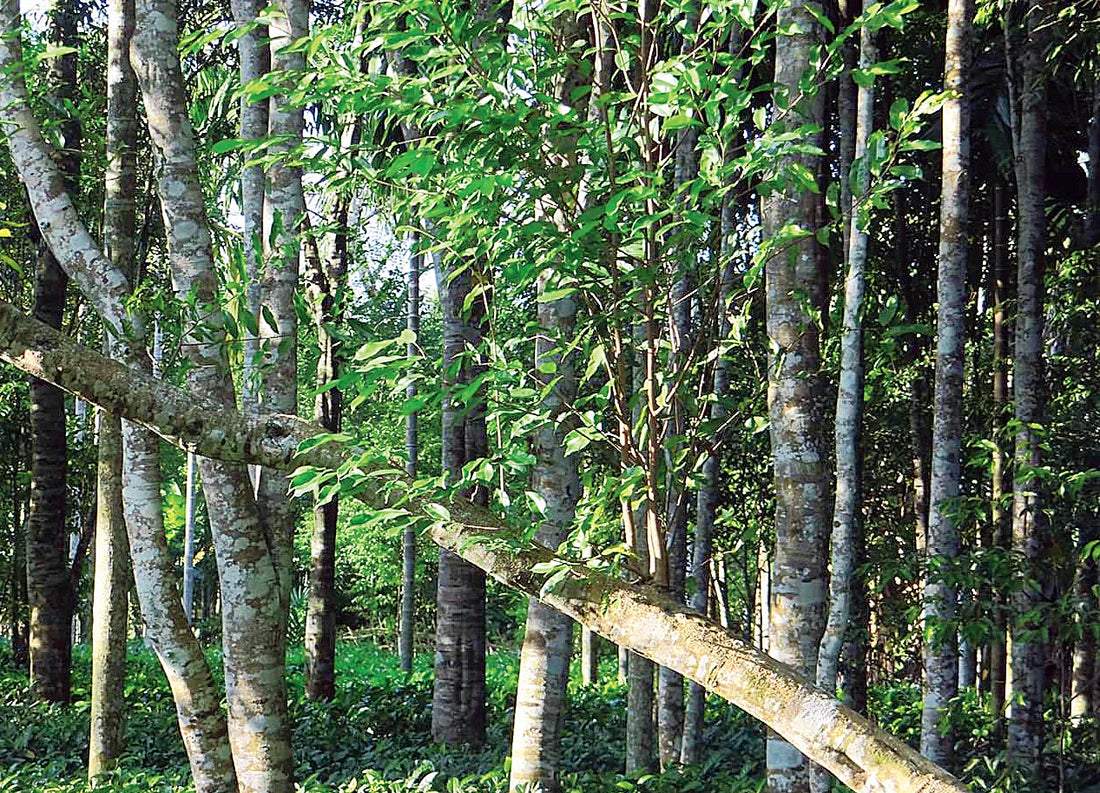

In the lush landscapes of Southeast Asia, the Agar Tree, scientifically known as Aquilaria agallocha, stands as an aromatic guardian, symbolizing a rich fragrance and cultural tradition. This distinguished tree, adorned with unique heartw Read more
Trending
Trees for Corporates
Agarwood Tree: A Fragrant Legacy
You may also like
Corporate Plantations
History of Agarwood
Explore the historical significance of agarwood and its use in various cultures and civilizations throughout history.
Agarwood Production Process
Detail the process by which agarwood is formed within Aquilaria trees, including the role of fungal infection and resin formation.
Types and Varieties of Agarwood
Discuss the different species of Aquilaria trees and the varying types and qualities of agarwood they produce.
Cultural and Religious Significance
Examine the cultural, spiritual, and religious significance of agarwood in different traditions and practices.
Agarwood in Perfumery
Explore the use of agarwood as a key ingredient in luxury perfumes and fragrances, including its scent profile and popularity among perfume enthusiasts.
Agarwood in Traditional Medicine
Discuss the medicinal properties attributed to agarwood in traditional Asian medicine, as well as modern scientific research on its potential health benefits.
Sustainability and Conservation
Address the importance of sustainable harvesting practices and conservation efforts to protect agarwood-producing trees from overexploitation and extinction.
Agarwood Market and Trade
Provide insights into the global agarwood market, including key players, trade regulations, and economic considerations.
Agarwood Cultivation and Farming
Offer information on techniques for cultivating agarwood, including inoculation methods and sustainable farming practices.
Agarwood as a Luxury Commodity
Explore the status of agarwood as a luxury commodity, including its value, demand among high-end consumers, and trends in the luxury goods market.
Agarwood Art and Craftsmanship
Highlight the use of agarwood in traditional crafts, such as carving and sculpture, and its role in artistic expression.
Agarwood Conservation Initiatives
Showcase ongoing initiatives and projects aimed at conserving agarwood-producing trees and promoting sustainable use of agarwood resources.
FAQ
What is Agarwood?
Agarwood, also known as oud or agar, is a highly prized aromatic resinous wood formed in the heartwood of Aquilaria trees when they become infected with a particular type of mold. It is renowned for its distinctive fragrance and is used in various cultural and religious practices, as well as in perfumery and traditional medicine.
How is Agarwood formed?
Agarwood formation occurs when Aquilaria trees undergo a natural defense mechanism in response to fungal infection. The infection triggers the tree to produce resin in the affected area, which gradually accumulates and darkens over time, resulting in the formation of agarwood.
What is the significance of Agarwood?
Agarwood holds significant cultural, religious, and commercial value in many societies across Asia and the Middle East. It has been used for centuries in various rituals, ceremonies, and medicinal practices. Additionally, agarwood is highly sought after in the luxury perfume industry for its rich and complex aroma.
Where is Agarwood found?
Agarwood-producing trees primarily grow in the forests of Southeast Asia, including countries like Cambodia, Vietnam, Thailand, Malaysia, Indonesia, and parts of India and Bangladesh. Aquilaria species are the primary source of agarwood, although other tree species in the Thymelaeaceae family can also produce similar resinous wood.
Is Agarwood sustainable?
Due to overharvesting and illegal logging, many agarwood-producing species are now endangered. Sustainable cultivation and harvesting practices, along with conservation efforts, are crucial for ensuring the long-term survival of agarwood-producing trees and the preservation of this valuable resource.
How do I identify genuine Agarwood?
Genuine agarwood is characterized by its distinct aroma, which can vary depending on factors such as the species of tree, the region it was harvested from, and the aging process. Additionally, authentic agarwood typically has a dark, resinous appearance and sinks when placed in water due to its high resin content. However, due to the prevalence of counterfeit products, it's advisable to purchase agarwood from reputable sources.
Is Agarwood legal to trade?
The trade of agarwood is regulated by international agreements such as the Convention on International Trade in Endangered Species of Wild Fauna and Flora (CITES). Some agarwood species are listed as endangered, and trade restrictions may apply to them. It's essential to ensure compliance with relevant regulations and obtain necessary permits when trading agarwood products.
How do I store Agarwood?
Agarwood should be stored in a cool, dry place away from direct sunlight to preserve its aroma and quality. Properly stored agarwood can retain its fragrance for many years, and it's recommended to keep it in airtight containers or pouches to prevent moisture loss.
Can Agarwood be cultivated?
Yes, agarwood cultivation is possible through various methods, including inoculation techniques to induce resin formation in Aquilaria trees. Cultivated agarwood, often referred to as "sustainable agarwood," offers a more ethical and environmentally friendly alternative to wild-harvested agarwood and helps alleviate pressure on endangered species.
Most Popular
Connect with us
-
👥 Corporates
If you are looking for:
- 🌲 Tree Plantation Events
- 📊 CSR Projects
📧 corporate@growbilliontrees.com
📞 +91 9699723523
💬 +91 9325931304 WhatsApp (Only)
🕒 Mon - Sat | 10am - 7pm IST
-
🧩 Tree Plantation NGOs
If you are looking for:
- 💰 Financial Assistance
- 🤝 Operational Support
📧 support@growbilliontrees.com
📞 +91 9699723523
💬 +91 9325931304 WhatsApp (Only)
🕒 Mon - Sat | 10am - 7pm IST
-
🌼 Individuals
If you are looking for:
- 👥 Group Tree Plantation Drive
- 🌳 Bulk Tree Plantation
📞 +91 9699723523
💬 +91 9325931304 WhatsApp (Only)
🕒 Mon - Sat | 10am - 7pm IST





















